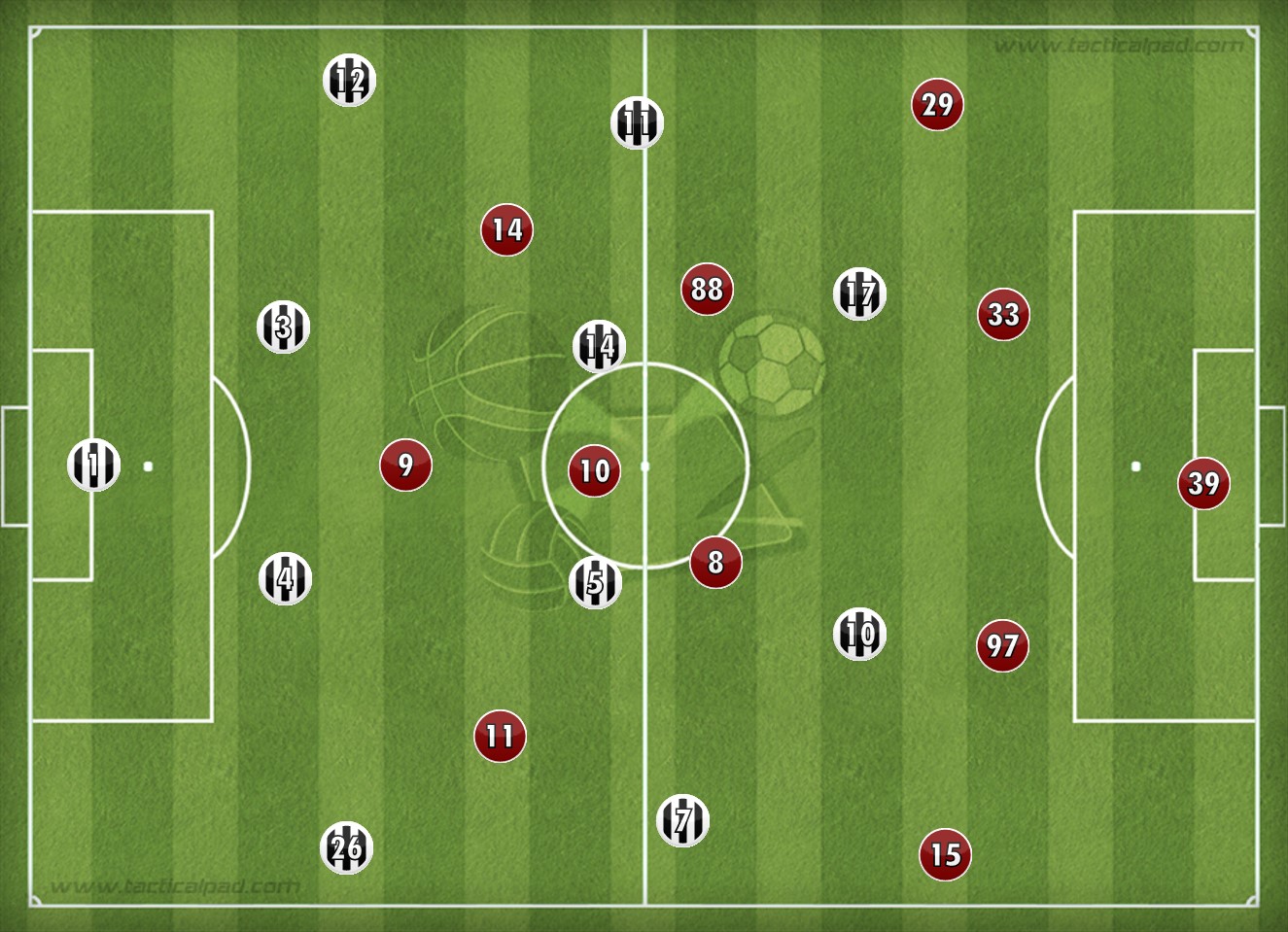Ryan Tank writes a detailed tactical analysis about the Serie A match that ended Juventus 4-0 Torino.
Torino suffered from tactical issues both in and out of possession. Juventus, on the other hand, not just managed to perform their high energized press, but, in attack, they easily generated access because Torino were not able to display a stable press against Juve’s posessession. In the 24th minute, Baselli was red carded. Added to the fact that Juventus led by one goal, the red card made it nearly impossible for Torino to even end the match with a draw.
Juventus: Buffon, Lichtsteiner, Benatia, Chiellini, Sandro, Cuadrado, Pjanic, Matuidi, Costa, Dybala, Mandzukic
Torino: Sirigu, Silvestri, Nkoulou, Lyanco, Ansaldi, Rincon, Baselli, Falque, Ljajic, Niang, Belotti
Torino Disconnect in Both Phases
Daniele Baselli was the important part of Torino’s early third build up and progression. He situationally dropped into the back line, forming a back three against Juventus’ 4-4-2. If no adequate short option for gradual progression was available, Torino would play it long right to the widest player (usually to Niang).
At times the spacing of Baselli and the two center halves managed to break The Old Lady’s first line of pressing. The back 3 enabled Torino to: (1) access Baselli when one of Juve’s forwards (usually Mario Mandzukic) ran toward Salvatore Sirigu or (2) create space for the far side center back to progress with ball.
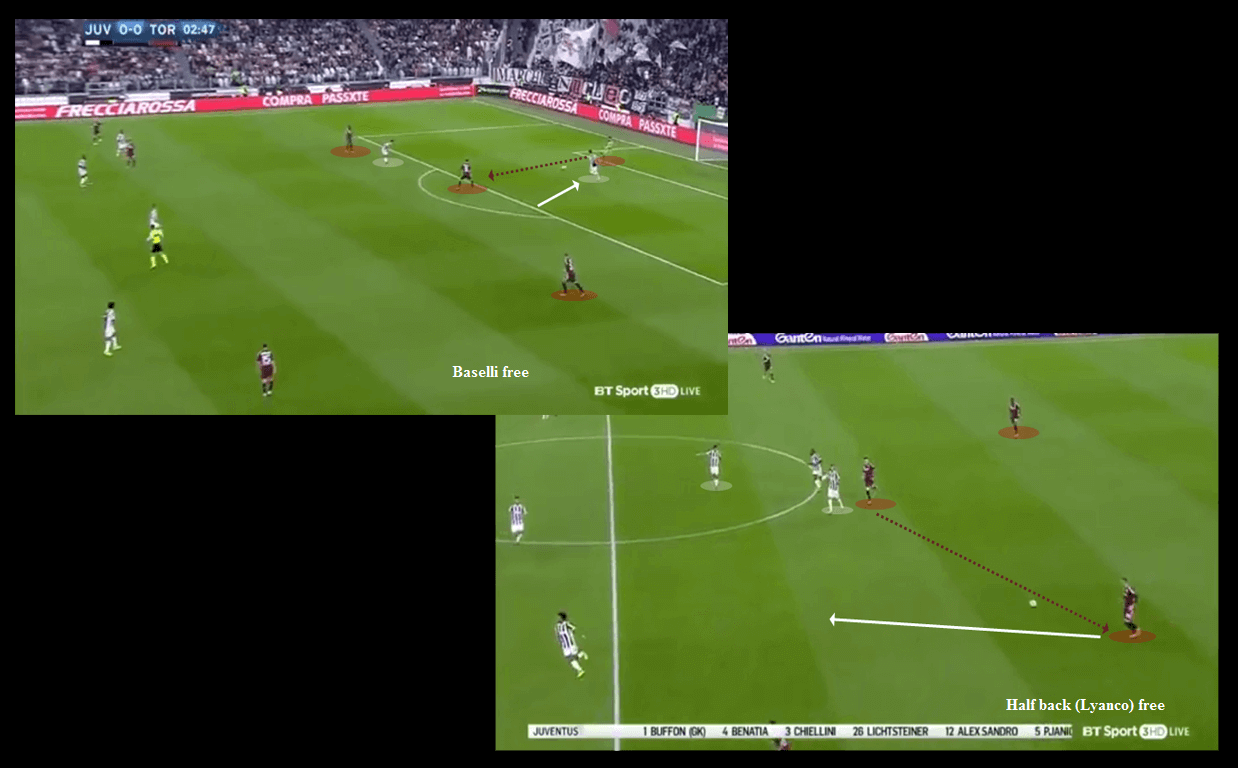
Torino build up out of the back
On other occasions, Torino’s first wave of possession also managed to make use of Mandzukic’s tendency to press onward. In the middle press, for example. Juve established a 4-4-2 pressing shape. When Torino played it wide to the fullback, Mandzukic would move onward to block the back passing lane to Torino’s close center back. Mandzukic’s onward press changed the basic shape of press from 4-4-2 to a 4-4-1-1. As a consequence, the diagonal passing lane was opened. A pass from the ball carrying full back to the 6 space would have reached Baselli since Dybala’s positioning was not ideal to easily access Baselli.
From their initial third, Torino often circulated it to the wide areas trying to invite Juve’s middle line to come out and spread wide. The visitors tried to create space behind Juve’s middle line as it also widened the space for the last line. This was especially needed when they played the ball right to Belotti who occupied the center space. But, when they managed to access Belotti, the issue was identified. Lack of deep runs around the receiver or a bad first touch by the receiver made it hard for Torino to penetrate into Juventus’ 18-yard box.
But, to say it was all down to Torino’s mistakes was quite disrespectful to Juventus’ pressing play. Massimo Allegri’s players also made it hard for Torino to develop their attack. For example, when Adem Ljajic dropped to the middle third to overload the ball side half space, Juve’s ball side central midfielder (CM) would step up and block the diagonal lane to the center which also isolated Torino’s wing oriented attack.

Pjanic stepped up and blocked the diagonal lane to the center and eliminated the chance for Ljajic to directly play it to Belotti
As mentioned above, Torino also displayed some weaknesses within their press. In general, Belotti and co pressed in a high block. They started the press with 4-2-3-1 while continuously trying to develop the press using a man oriented approach.
There were two big issues here: (1) the pressing coordination between the forward line and the lines behind it and (2) the harmony during the horizontal shift. Juventus managed to play to this weakness and aided their own ball possession. For example, an uncoordinated press between Belotti and the three attacking midfielders behind him made it hard for the nearest pivot (Rincon) to step forward to put a press on his opposite CM and, at once, to cover the vacated 6 space. With a simple lateral movement, Matuidi would easily drag Rincon out wide and consequently weaken Torino’s coverage of their own 6 space as well as ease Juve’s to access it.
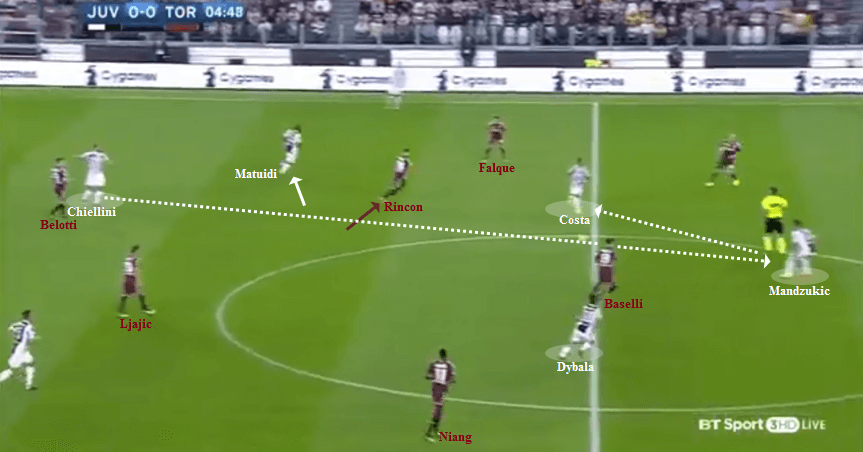
Torino’s press allowed progression access. See Belotti, Ljajic, Matuidi, Rincon, and the pass from Chiellini to Mandzukic
As the vertical passing lane was opened up, Giorgi Chiellini played an aggressive forward pass to Mario Mandzukic. The tactical situation was supported well by the strong spacing. As we can see above, there is a diamond shape as Douglas Costa inverted to the near half space. Costa’s movement also provided an easy one touch pass for Mandzukic to the Brazilian. From Mandzukic’s pass, Costa played it far to the right hand side to the onrushing Stephane Lichtsteiner (not shown in the photo).
Such a weak press can be seen both in Torino’s high press and deep press. In the high press, it occurred during the horizontal shift when Torino were trying to deal with Juventus’ horizontal circulation. As shown in the 9th minute, Torino didn’t make a proper horizontal shift during their press against Juve’s possession-switch from the left sector to the right one. This was evident if you take a look at Rincon and Falque who occupied Juventus’ left half space. They stayed in the advanced areas and didn’t make the intense diagonal backward movement as needed to cover the central space. This, in turn, made it easy for Juventus to generate an up-back-through pattern followed by a fast forward dribble by Dybala into zone 14 which ended up with Baselli fouling the Argentinian.
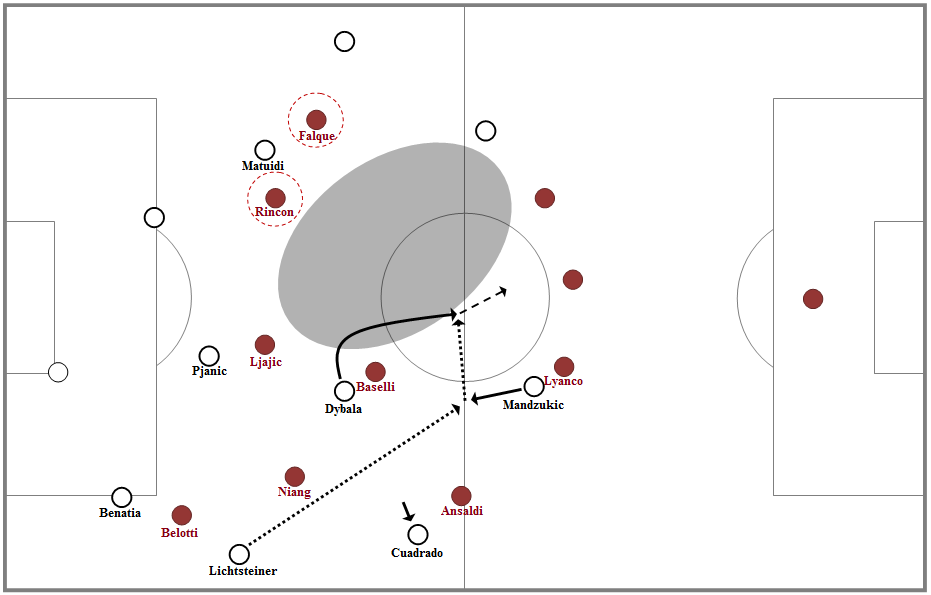
Unharmonized horizontal shift allowed space in the center (grey elips area). Take notice on Rincon and Falque whose passivity means no diagonal-backward press to cover the central space
As mentioned above, a similar weakness came up during Torino’s deep block. Ljajic, in the 10 space, at times lost his access to the Juve pivot that stayed in the center during Juventus’ wide attack. For example, Costa and Alex Sandro made a short combination on the left flank. When they found it difficult to play through Torino’s local overload, there would be a switch of play (usually by Costa). Strategically, Torino had to make sure they maintained an adequate coverage in the center as it might (1) halt Juventus from quickly switching to the weak side on the right half space and flank or (2) force Juventus to play it back to the defending line. But, they didn’t. As stated above, Ljajic lost the access to the said space, and he allowed space for Matuidi to receive a pass from Costa before shifting to the right side.
Juve Strong Pressing (And Counterpress)
As expected prior to the match, Juventus would display their high man oriented press. There were different pressing behaviors between the high press and the middle press. In high press, Dybala and Mandzukic would go high up the pitch and attach themselves to Torino’s center halves as well as keep continuing the press towards the goalie. In the middle press, the two forwards occupied Torino’s 6 space and slightly held themselves back from directly pressing the central defender duo. In the middle press, there was the hybrid of man oriented and position oriented pressing by the first line. The pressing intensity would arise with some specific triggers. One was when the ball was played to the wide area. In a touchline press, the near forward’s orientation was to block the passing lane to Torino’s 6 space. And situationally, the near forward was oriented to block the back pass to Torino’s back line.
The set up was a common set up in defensive play. One of the most striking and amazing aspect in Juventus’ press was the intensity which was established by the individual physicality. Juventus’ players were able to cover lots of ground easily. For example, we can see the speed, anticipation, and timing of Mandzukic’s-goal-keeper-press often caused Torino’s back line to lose their composure which was followed by many uneasy passes. The other ultimate example was the first goal by Dybala. The goal was triggered by a counterpress after a missed pass.
Strategically and generally speaking, Juventus’ counterpressing access prior to the 1st goal was not that optimum. After Lichtsteiner’s chipped pass fell to Nkolou, there was huge space and time for Torino’s back line to reshape their formation to create a more ideal formation for building up the attack. But, the risky decision-making by Torino’s players along with Juventus’ individual physicality allowed Blaise Matuidi to intercept a forward pass from Basille. The ball fell onto Rincon’s feet. But, Miralem Pjanic’s good pressing access to Rincon made it easy for the 8 to tackle Rincon before Dybala recovered it and converted into the first goal.
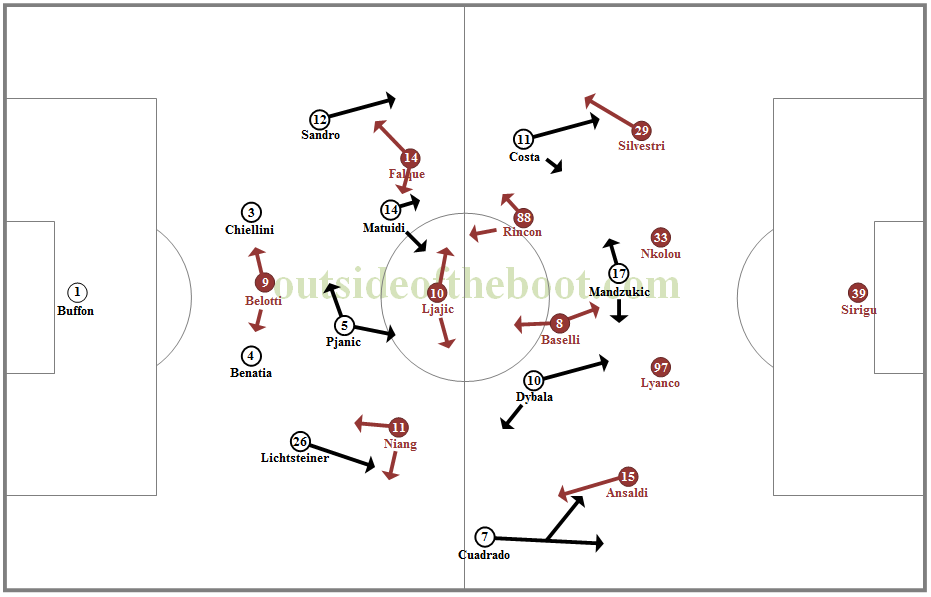
Lineups before the red card
Torino switched to 4-3-2/4-4-1
A red card for Baselli had made it even more difficult for Torino. Niang was dropped to the left side and Torino played with a 4-4-1 shape. With 4-4-1 it was noticeable that Torino was finding it highly difficult to disrupt through Juventus’ first line of build-up. Too much space on both sides of Belotti made it easy for Juventus to generate vertical passes from the back line to the half spaces of Torino’s 6 line. Such a progression was generated by a simple manipulation by Matuidi. He was able to drag Rincon out of position very easily. With a lot of spatial advantage, the receiver then easily decided where to continue the play, whether to the wide areas or to play it directly into the 18-yard box.
Sinisa Mihajlovic saw it as a huge weakness. He decided to take Falque out replacing him with Acquah. With this, Torino switched to a 4-1-2-2. The back four still the same. In the midfield, Acquah filled the right 8 space, Ljajic at 8 left, and Rincon as the 6 covering the space in front of the back line. In the forward line, Niang was paired with Belotti to secure the central space. The change of the basic shape, from 4-4-1 to 4-3-2 seemed to be done with the intention of maintaining a strong presence in the back line in case of a counter attack generated.
With 2 players upfront, Torino improved their pressing. A situational backward move by Niang or Belotti into the middle line transformed Torino into a 4-4-1-1. If this was done properly they could hold Juventus from generating valuable access from the wide areas. For example, when Juve used Matuidi to overload the half space in Torino’s midfield line, Belotti would follow Matuidi’s movement. This movement by Belotti was the movement that made Torino play with 4 midfielders. Sometimes such a backward press was triggered by the forward player who followed Juve’s ball side full back who moved far up to approach Torino’s defensive third.
But, generally, it still was difficult for the visitors to constantly secure the middle line as it was needed to block Juventus from directly accessing Torino’s back line. One of the situations when Torino found it difficult to provide ideal-strong cover to the middle line was: Juventus managed to switch from side to side; Torino middle line was occupied by three players; Torino’s ball side full back was dragged wide because he had to put a press on Juventus’ ball side winger.
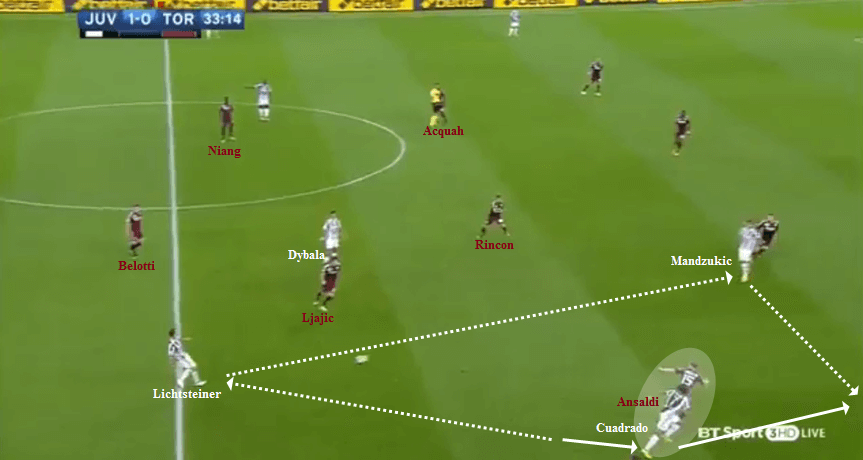
Juventus manipulated Torino’s middle three and the back line. After receiving a pass from Chiellini (not shown in the photo), Cuadradoplayed it back to the near full back (Lichtsteiner) and stayed on the wide post. His positioning managed to drag Chrsitian Ansaldi with him. A pass from Lichtsteiner to Mandzukic generated the chance for the hosts to penetrate into the final third after a wall pass from Mandzukic managed to reach the onrushing Cuadrado
The fact that the opponent had to play with a basic shape of 4-3-2 had been making it easy for Juve to apply their wing oriented circulation. They comfortably played forward into the final third to a player in the half space only to play it back to the defensive line and switched it quickly to the opposite wing. The second goal came from such a situation. A switch by Pjanic to the wide left was followed by a floating cross into the box. The ball fell to Cuadrado’s feet before being cut-back to the onrushing Pjanic who made a shot from the D space in front of the box.
The 2nd Half: Juventus’ Spacing Too Strong To Play Against
Another strategic change and tactical alteration was made by Torino. As Juventus were looking very comfortable dismantling the Torino middle line which indirectly also harmed the back line, Mihajlovic decided to apply another strategic change. With the first one, he was back to the 4-4-1 with the initial risk of losing the first line, but more security to the second line and the back line. The other change he made was to focus more on the left hand side (Ljajic there) and adjusted the attacking assignment of his middle line players. Generally, the change is shown below.
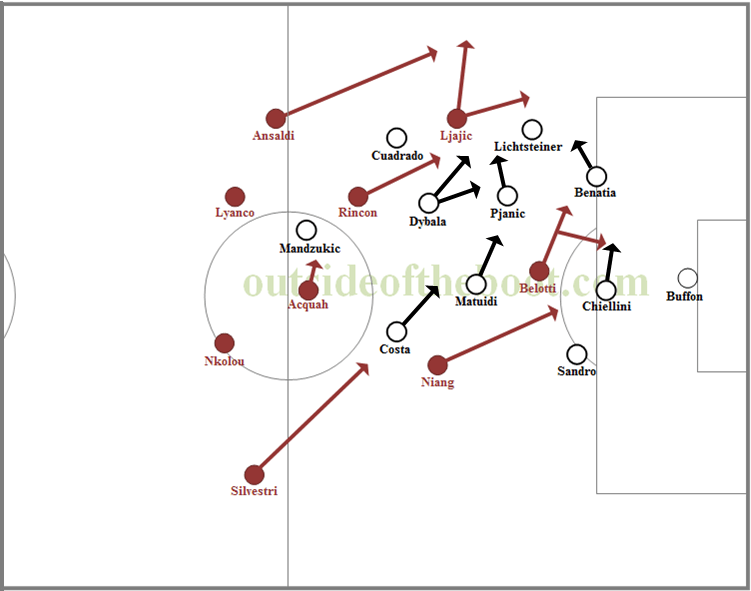
Torino’s left focus. The rough assignment
In their left focused attack, Ljajic was supported by Rincon as the near 8 and Ansaldi, the left full back. Practically, there were many position swaps between Ljajic and Rincon. At times, Rincon even moved far forward and acted as the depth. Belotti, situationally got involved in this overload. He also provided the depth in this local overload as well as got into the danger zone, along with Niang to act as the chance executor. To stabilize the defensive transition, Silvestri and near center back would step forward toward the final third along with Acquah to shield the crucial area.
Juventus used a 4-4-1-1/4-5-1 basic shape to deal with such an attacking focus. First thing they did during this phase was assign both pivots to follow Torino’s central midfielders. This made them stay close almost all the time during such phases.
The other key was Dybala. The player of the match dropped very deep to get closer to Pjanic-Matuidi space to form strong overload to block any of Torino’s diagonal access. Dybala was even able to cover the space behind Pjanic as the central midfielder stepped forward to close down Torino’s ball carrier. Dybala’s backward behaviour often managed to (1) stop Torino from generating a qualitative superiority and (2) create numerical superiority in Juventus’ defensive midfielder post.
But, Dybala didn’t do this exclusively. For example, when Torino’s left-sided attack approached Juve’s early build up with only two players, for instance, Dybala would prefer to stay higher but still kept an eye on any additional and direct threat by Torino’s deeper player. He didn’t simultaneously drop deep to build a strong pressing barrier as it wasn’t always needed.
Mandzukic, on the other hand, constantly secured the center space. He mostly stayed forward, at 9, to maintain the vertical presence. But, situationally, these two forwards were found dropping very deep and made Juve defended in a 4-4-1-1-0/4-5-1-0 (strikerless).
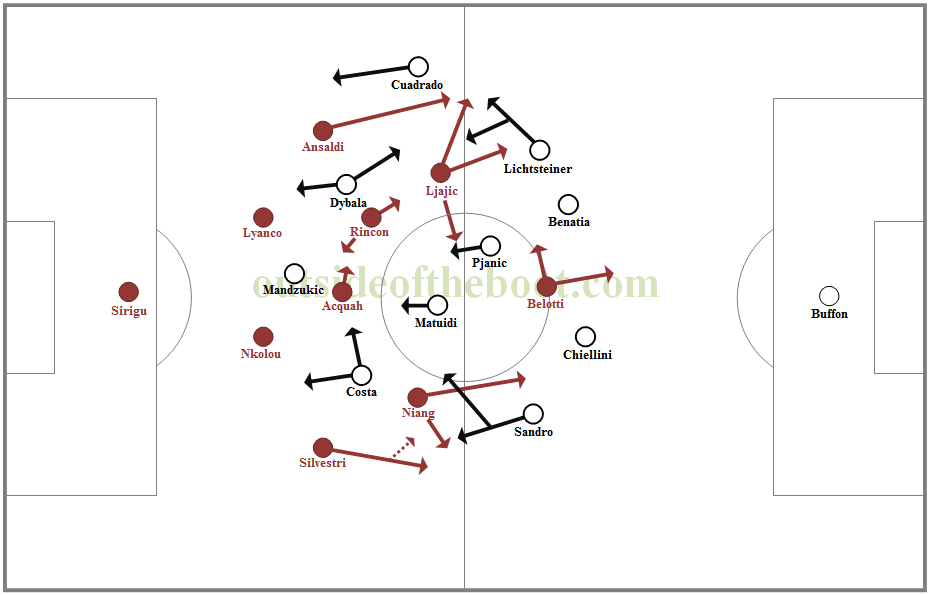
The 4-2-3-1 vs 4-4-1 of the second half
Torino’s left sided attack and Juve’s pressing behaviour had influenced their offensive-phase. In attack, as Costa started from the left half space near the center, he often managed to make a recovery and carried the ball toward the center or even to the right half space. With his dynamic running, Costa was able to carry the ball quickly from one half space to the other half space. In this situation, when need to switch the play to the other side arose, there would have been Matuidi replacing Costa in the far half space.
Juve deserved this win. Not because Torino played with 10 men for most of the game but, Juventus were obviously the stronger side. They were tactically better, with better intensity in the pressing execution and also better dynamic within the attacking phase.
- Tactical Analysis: Roma 3-0 Chelsea | Chelsea’s Possession Play Failed to Tear Down Roma’s Fortress - November 4, 2017
- Tactical Analysis: Tottenham Hotspur 3-1 Real Madrid | Spurs Make A Statement - November 2, 2017
- Tactical Analysis: Manchester United 1-0 Tottenham Hotspur | United Secure An Important 3 Points - October 29, 2017




















































